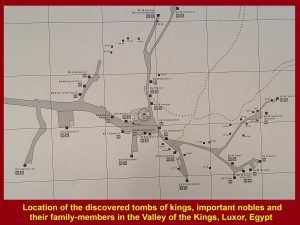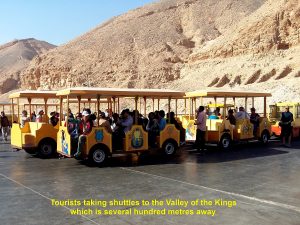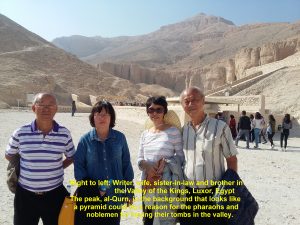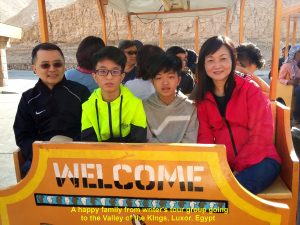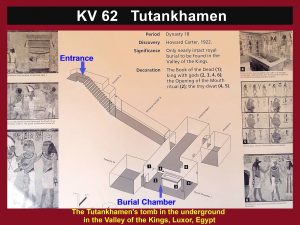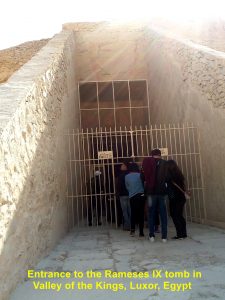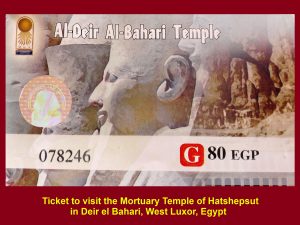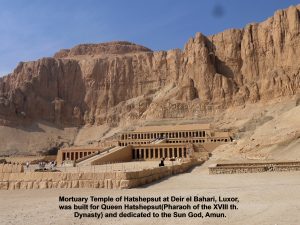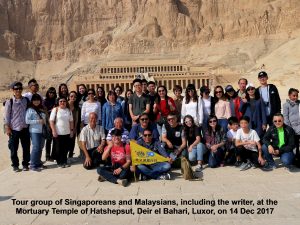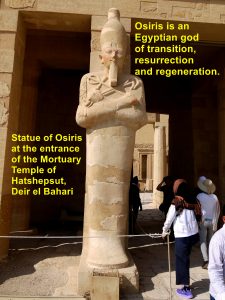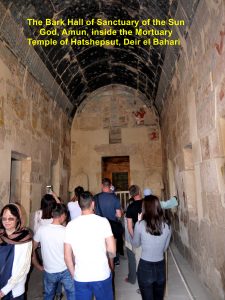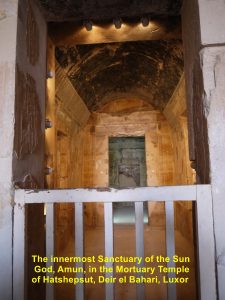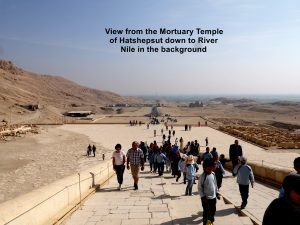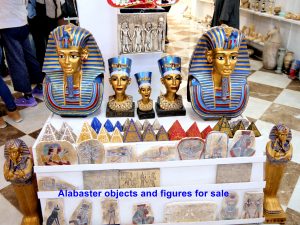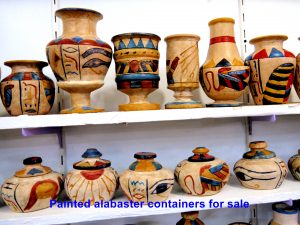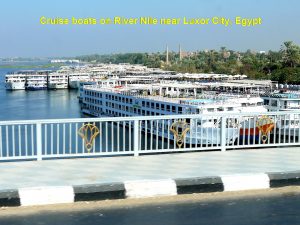Egypt Travel Part II: Valley of the Kings, Hatshepsut Temple and Colossi of Memnon
Egypt Travel II: Valley of the Kings, Hatshepsut Temple and Colossi of Memnon
Day 2 Thursday, 14 Dec 2017
Flying from Cairo to Luxor by Egypt Air
Early in the morning we left Le Meridien Pyramids Hotel in Cairo and went to the airport nearby. At the airport we took an Egypt Air plane and flew to Luxor which is about 500 km in the south.
Map showing the location of Luxor, Egypt
Tour group boarding an Egypt Air plane at Cairo Airport
Luxor Airport
After flying for about an hour and 10 minutes , we arrived at the Luxor International Airport.
We were going to spend two days in Luxor making a few visits and doing some activities.
The first place we visited in Luxor was the Valley of the Kings.
Valley of the Kings
Located on the west bank of River Nile near Luxor city, Valley of the Kings is a necropolis or cemetery for the kings, powerful noblemen and their family members of the New Kingdom(18 – 20th. Dynasties of Ancient Egypt). From 1539 until 1075 B.C., a period of about 500 years, those deceased were buried there. So far about 63 tombs have been discovered but most of the treasures belonging to them were looted.
The first king to be buried there was Thutmose I(1504 – 1492 B.C.) and the last one was Ramesses XI who died in 1077 B.C.
Photos of the Valley of the Kings
Entry Ticket to the Valley of the Kings
Visitors have to buy a ticket to visit the Valley of the Kings and it looks like the one below.
Shuttles
Shuttles will bring visitors to the valley which is several hundred metres away from the entrance.
Writer and Family
Writer, wife, brother and sister-in-law went to the valley together to see the tombs of well-known ancient Egyptian kings and nobles.
A Happy Family
A happy family together with the rest of the tour group went to the Valley of the Kings.
Paths to the Tombs
There are paths leading to all the known tombs in the valley.
Tutankhamun Tomb
The most famous tomb was that of King Tutankhamun. Tutankhamun became king at the age of 9 in 1332 B.C. and ruled Egypt for 10 years before he died at the age of 18 in 1323 B.C. Nobody knows the exact cause of his death. Many scientists thought he died of a disease.
Howard Carter
Tutankhamun tomb was discovered by an English archaeologist, Howard Carter, in 1922 and found to be almost intact. Most of his possessions were still in the tomb, including his golden mask that is now in the Egyptian Museum in Cairo.
“Curse of the Pharaoh”
8 of the 58 people who were present when Pharaoh Tutankhamun’s tomb(sarcophagus) was opened died a few years later. Rumours of a “curse of the pharaoh” were spread by newspapers to boost their sales. Many of them lived a long life including Howard Carter who died in 1939 at the age of 64, 13 years after he and others discovered the Pharaoh Tutankhamun’s tomb in the Valley of the Kings.
Entrance to the tomb of Pharaoh Tutankhamun in the Valley of the Kings
Tutankhamun Burial Chamber
The diagram below shows the burial chamber of Tutankhamun deep in the ground in the Valley of the Kings.
Tomb of Ramesses II’s Sons
This tomb for Ramesses II’s sons is the largest in the Valley of the Kings in Luxor. The pharaoh ruled Egypt from 173 B.C. until 1213 B.C. and had more than 160 children.
j. Tomb of Ramesses IX
Ramesses IX ruled Egypt from 1129 B.C. until he died in 1111 B.C.. His tomb is in the Valley of the Kings, Luxor.
k. Ramesses VII’s Tomb
Ramesses VII ruled Egypt from 1136 B.C. until he died in 1129 B.C.. He was succeeded by Ramesses III’s son, Ramesses VIII, who ruled Egypt for a year(1129 – 1130 B.C.).
l. Merenptah’s Tomb
Merenptah was the 13th. son of Ramesses II and ruled Egypt for 10 years from 1213 B.C. until he died in 1203 B.C..
Visit to the Mortuary Temple of Hatshepsut, Deir el Bahari
In the afternoon we left the hot and dry Valley of the Kings and went to the other side of the mountain where a mortuary known as Mortuary Temple of Hatshepsut was located.
Entry Ticket to the Mortuary Temple of Hatshepsut, Deir el Bahari
Mortuary Temple of Hatshepsut
Mortuary Temple of Hatshepsut was built at the bottom of the cliffs of Deir el Bahari close to the Valley of the Kings and on the west bank of River Nile in Luxor. It was built for Queen Hatshepsut, the Pharaoh of the 18th. Dyanasty who ruled Egypt from 1478 B.C. until 1458 B.C., and dedicated to the Sun God, Amun-Ra.
Queen Hatshepsut’s tomb is believed to be in the Valley of the Kings.
Photos at the Temple
Here are some photos taken at the temple site.
Panoramic View of the Mortuary Temple of Hatshepsut in Deir el Bahari, West Luxor
Tour Group at the Mortuary Temple of Hatshepsut
A Restored Sphinx at the Mortuary Temple of Hatshepsut
Statues of Osiris at the entrance of the Mortuary Temple of Hatshepsut
Ancient Egyptians believed that Osiris was the god of transition, resurrection and regeneration. Many large statues of that god can be seen in front of the temple.
Bark Hall Entrance of the Mortuary Temple of Hatshepsut
Entrance to the Bark Hall of the Sanctuary of the Sun Deity, Amun-Ra, in the Mortuary Temple of Hatshepsut

Entrance to the Bark Hall of the Sanctuary of the Sun Deity, Amun-Ra, in the Mortuary Temple of Hatshepsut
Bark Hall of the Sanctuary of the Sun God, Amun
The innermost Sanctuary of the Sun Deity, Amun
Panoramic view outside the Mortuary Temple of Hatshepsut
View from the temple to River Nile in the background
Visit to Abd Shanab Alabaster Shop
After the visit to the Mortuary Temple of Hatshepsut, we went to a shop, Abd Shanab Alabaster, in Luxor town to learn about alabaster carving of ancient Egyptian objects.
Abd Shanab Alabaster
When we arrived at Abd Shanab Alabaster shop its workers showed us the method of sculpturing alabaster stones into ancient Egyptian objects and figures.
Then we entered the shop and were introduced to many ready-made products which were for sale. They were beautifully made with details. The photos below show some of them displayed in the shop.
Colossi of Memnon
Soon we left the shop and went to a bank of River Nile in town to board a cruise boat called Jamina. On the way we saw two giant statues, Colossi of Memnon. They were both statues of Pharaoh Amenhotep III, the 9th. Pharaoh of the XVIIIth. Dynasty(1550-1292 B.C.). They were found buried in the ground many years ago and restored with many missing parts.
Cruise Boats on River Nile
When we arrived at the bank of River Nile, we saw many cruise boats and we boarded one of them known as Jamina. We would cruise on that boat from Luxor to Aswan in the south for four days stopping at some cities to visit their historical sites.
Egypt Travel Parts I to XII
Egypt Travel Part I :Salah el Din Citadel, Muhammad Ali Mosque, Tahrir Square and Egyptian Museum
Egypt Travel Part II :Valley of the Kings, Hatshepsut Temple and Colossi of Memnon
Egypt Travel Part III :Hot Air Balloons and Karnak Temple Complex
Egypt Travel Part IV :Papyrus Paper-Making, Luxor Temple and Esna Lock
Egypt Travel Part V :Edfu Temple, Kom Ombo Temple and Galabia Party
Egypt Travel Part VI :Abu Simbel Temples and Nubian Village(Elephantine Island)
Egypt Travel Part VII :Unfinished Obelisk, Aswan High Dam and Philae Temple
Egypt Travel Part VIII:Ahmed Hamdi Tunnel, Moon Beach(Ras Sudr), and St. Catherine
Egypt Travel Part IX :Mount Sinai, Catherine’s Monastery and Sharm el Sheikh
Egypt Travel Part X :Sharm el Sheikh
Egypt Travel Part XI :Cairo Food, Saqqara Step Pyramid Complex and Memphis
Egypt Travel Part XII :Great Giza Pyramid Complex and Khan el Khalil Bazaar
Comments
Tell me what you're thinking...
and oh, if you want a pic to show with your comment, go get a gravatar!




